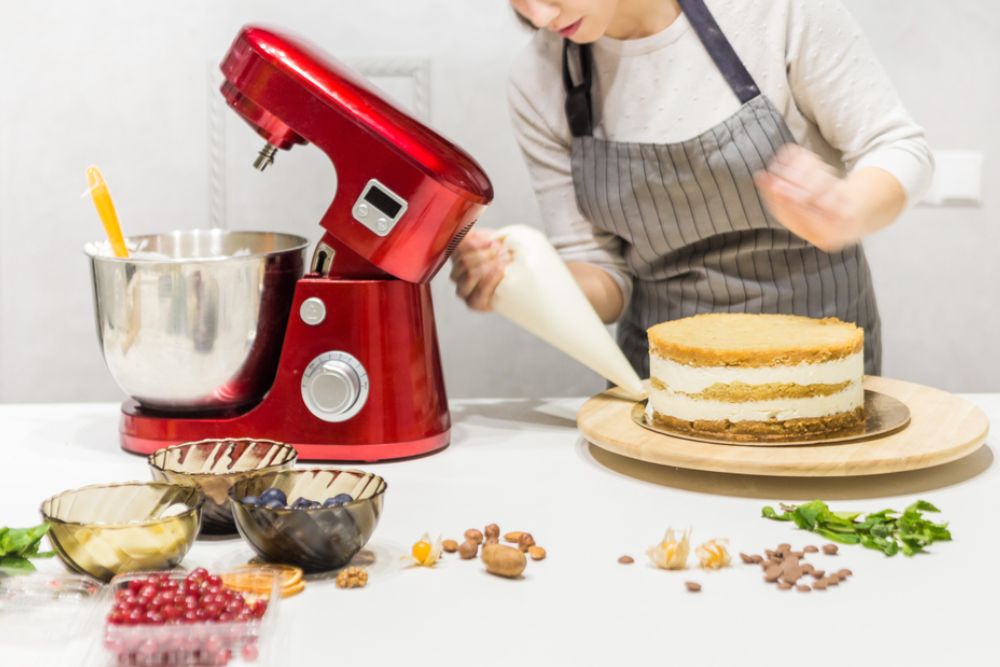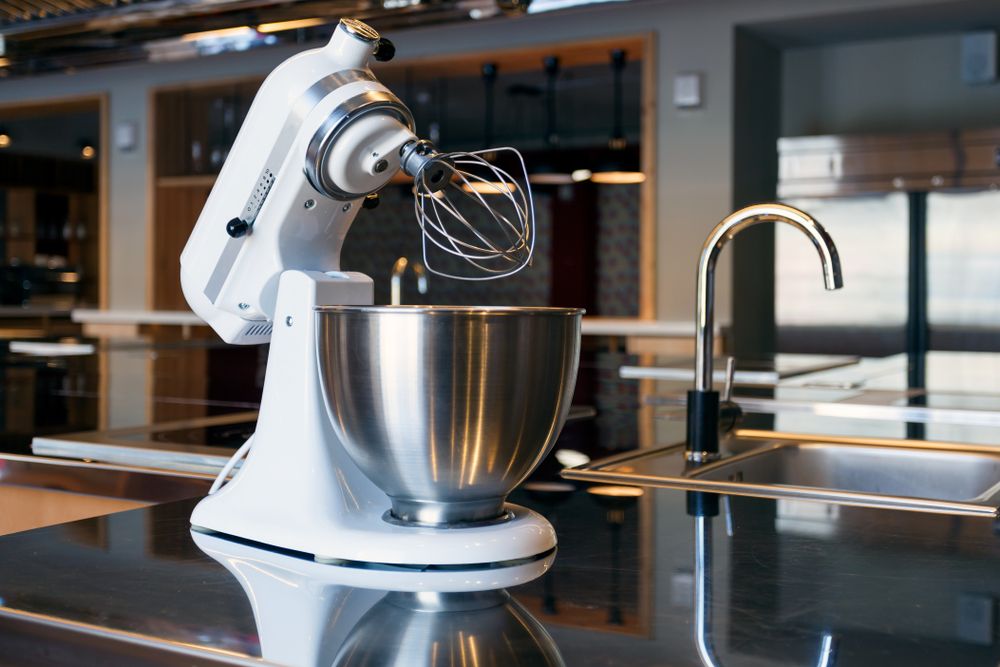From whipping up fluffy meringues to kneading bread dough, a stand mixer can be a game-changer for both novice and experienced bakers. It not only streamlines repetitive tasks but also delivers consistency and precision difficult to achieve by hand. However, with so many brands, capacities, and features available, choosing the right stand mixer can feel daunting. This guide will walk you through the key considerations—like motor power, bowl size, attachments, and more—ensuring that your new mixer becomes a reliable ally in your baking adventures.
1. Why a Stand Mixer?
Why It Matters
If you bake often, you know that tasks such as creaming butter and sugar, beating egg whites, or kneading thick dough can be labor-intensive. A stand mixer frees up your hands and shoulders from repetitive motions, delivering consistent results at the turn of a dial. The stable base and efficient mixing action also help incorporate air more thoroughly, leading to lighter batters and perfectly elastic dough.
Key Benefits
- Time and Energy Savings: With a stand mixer, you can multitask—prep other ingredients or tidy up—while the machine does the mixing.
- Consistency: The mixer’s steady motor and attachments ensure an even blend.
- Versatility: Many models support add-on attachments (like pasta rollers or meat grinders), expanding your culinary repertoire beyond baking.
Takeaway: If baking is a frequent hobby or you routinely handle large or dense recipes, a stand mixer offers convenience, consistency, and the chance to explore more complex dishes.
2. Consider Mixer Type: Tilt-Head vs. Bowl-Lift
Why It Matters
Stand mixers generally come in two main styles, each with unique advantages. The choice often depends on available counter space, your comfort with adding ingredients, and bowl size preferences.
Tilt-Head Mixers
- Design: The top of the mixer (head) tilts back, letting you attach or remove the bowl and accessories easily.
- Pros: Simpler to change attachments or scrape the bowl; typically lighter in weight and often more compact.
- Cons: The head must be tilted to remove the bowl, requiring enough overhead clearance. May have slightly less capacity or motor power than some bowl-lift models.
Bowl-Lift Mixers
- Design: The bowl attaches to arms that raise or lower the bowl into mixing position, leaving the mixer’s head stationary.
- Pros: Often found on higher-capacity or professional-grade mixers; stable for heavy doughs.
- Cons: Bulkier footprint, can be trickier to add ingredients mid-mix due to the bowl’s stationary height.
Takeaway: If you have limited overhead space or prefer a lighter, more straightforward design, a tilt-head mixer might be best. Bowl-lift models suit serious bakers tackling large batches or dense doughs regularly.
3. Bowl Capacity and Size
Why It Matters
One of the first considerations is matching the mixer’s bowl size to your typical recipes. Buying too small a bowl leads to cramped mixing (and potential spillage), while an overly large bowl might feel wasteful or unwieldy if you only bake in small batches.
Common Sizes
- 3.5- to 4.5-Quart Bowls: Ideal for occasional bakers or small households. Perfect for one or two loaves of bread or single batches of cookies.
- 5- to 6-Quart Bowls: A popular middle ground—enough to handle bigger cookie batches, multiple loaves of bread, or double-layer cake batters.
- 6.5+ Quart Bowls: Suited for large families, frequent bakers, or those who bake in bulk (e.g., wedding cakes, big bread batches).
Takeaway: Evaluate your typical recipes—especially the largest volume you’d mix at once. A 5-quart bowl is a safe bet for most home bakers; smaller or larger might be warranted depending on your routine.
4. Motor Power and Wattage
Why It Matters
The motor’s strength dictates how effectively the mixer can handle dense doughs (like bread or pizza) or large batches of batter without straining. A weak motor may overheat or struggle, affecting the mixer’s longevity and consistency.
What to Look For
- Wattage: Often ranges from 250W to 500W (or higher for professional models). More wattage generally implies greater power, but brand design matters too.
- Torque vs. Wattage: A 300W motor from a reputable brand can sometimes outperform a 350W motor from a cheaper brand. Consider real-world performance, not just the numbers.
- Overload Protection: Some mixers feature safety mechanisms that shut down the motor if it overheats—beneficial for bread kneading marathons.
Takeaway: Higher wattage typically correlates with smoother performance on tough tasks, but read reviews or test the model’s real-world capabilities if possible. Aim for at least 300W if you plan to knead dough regularly.

5. Essential Attachments and Accessories
Why It Matters
Your mixer’s functionality hinges on attachments like the flat beater, dough hook, and whisk. Some brands also offer specialized accessories (like pasta rollers, spiralizers, or juicers) that expand your machine’s scope beyond baking.
Must-Have Attachments
- Flat Beater (or Paddle): For cookies, cakes, and general mixing.
- Dough Hook: Spiral or C-shaped hook for kneading bread or pizza dough.
- Wire Whisk/Whip: Whips air into cream or egg whites for meringues and whipped cream.
Optional Extras
- Flex Edge Beater: Has a silicone edge that scrapes the bowl’s sides—handy if you dislike stopping to scrape manually.
- Pouring Shield: Helps add ingredients without splattering.
- Specialty Tools: Some brands let you attach pasta makers, meat grinders, or spiralizers.
Takeaway: Ensure the core trio of attachments (beater, dough hook, whisk) is included. Additional attachments can be a bonus if you see yourself using them often.
6. Speed Settings and Controls
Why It Matters
A range of speeds helps you fine-tune mixing intensity—slowly stir in delicate ingredients or whip egg whites at high speed for meringues. The number of speeds is less important than having a smooth gradient from low to high.
Common Features
- Variable Speeds (Usually 6–10): Let you start gently (minimizing splatter) and ramp up to high power.
- Slow Start Function: Some mixers have a “soft start” feature preventing flour clouds when mixing dry ingredients.
- Pulse Feature: Useful for short bursts of power or folding in sensitive items.
Takeaway: Aim for at least five or six speed settings, ensuring you can handle gentle mixing through intense whipping or kneading. Gentle starts can minimize mess in small kitchens.
7. Construction and Durability
Why It Matters
Stand mixers often are a long-term investment. Paying attention to the materials—especially the mixer’s body (metal vs. plastic) and gear system—can predict how well it endures frequent use.
Points to Assess
- Metal Housing: More robust and stable, though heavier. Typically found in mid- to high-end mixers. Plastic bodies can be lighter but might be less sturdy over time.
- Metal Gears vs. Plastic Gears: Metal gears usually handle torque better, crucial for kneading tough dough.
- Overall Weight: Heavier mixers can reduce wobble during kneading. But if you must frequently move it off the counter, you might prefer a slightly lighter design.
Takeaway: For serious bakers or heavy dough tasks, consider a metal-bodied mixer with sturdy gears. For lighter usage or limited storage, a smaller or plastic-bodied model could suffice.
8. Brand Reputation and Warranty
Why It Matters
Classic stand mixer brands—like KitchenAid, Cuisinart, and Kenwood—have loyal followings for good reason. Long warranties and robust after-sales support can be invaluable if something goes wrong.
What to Research
- User Reviews: Check real-world experiences, especially about motor reliability or parts wearing out.
- Customer Support: A brand known for helpful service can reduce stress if you ever need repairs.
- Warranty Length: Common warranties range from 1–5 years. Higher-end mixers may include extended coverage, signaling confidence in their build.
Takeaway: Balancing your budget with brand reputation is often wise. A well-regarded brand usually offers consistent performance, though some lesser-known brands can still be worth a look if reviews are strong.
9. Budget and Value for Money
Why It Matters
Stand mixers can range from under $100 to over $500. While premium models often deliver superior durability and motor power, many mid-range mixers are more than adequate for the average home baker.
Price Tiers
- Budget (Under $150): Basic tilt-head mixers with smaller bowls, often plastic or lighter metal bodies. Good for casual bakers.
- Mid-Range ($150–$300): Often 4.5–5 quart capacity, sturdy enough for moderate bread dough kneading. Typically have metal bodies and multiple speed settings.
- Premium ($300+): Larger bowls (5–7 quart), stronger motors, potential for more attachments, and better warranties.
Takeaway: Decide how often you’ll use the mixer and for what tasks. Serious bread bakers or frequent batch bakers might benefit from a more robust, higher-end machine. Occasional users or beginners may do fine with a mid-tier option.
A stand mixer is more than just a kitchen gadget—it’s a baking partner that can streamline your recipes, save time, and encourage culinary creativity. The best mixer for your needs hinges on factors like capacity, motor strength, attachments, and the type of tasks you’ll tackle most often (like kneading heavy dough or gently folding cake batter). Consider whether a tilt-head or bowl-lift design makes sense for your kitchen layout, and pay close attention to brand reputation and warranty coverage if you envision frequent or heavy use.
While it’s tempting to pick the biggest or most powerful model, sometimes a compact mid-range mixer strikes the perfect balance for your countertop space and budget. Start by clarifying how you plan to use it—light baking, occasional pizza dough, or full-scale weekly bread production. Armed with this knowledge, you’ll be primed to invest wisely in a stand mixer that elevates your baking game and lasts for years to come.





